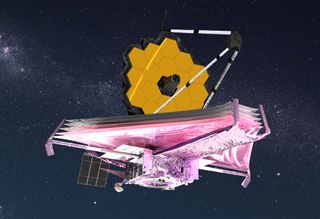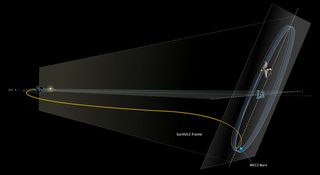James Webb Space Telescope arrives at new home in space

After traveling almost a million miles, NASA's James Webb Space Telescope reached its final destination today (Jan. 24).
The most powerful observatory ever to launch to space, the James Webb Space Telescope lifted off on Dec. 25, 2021 to explore the cosmos and our universe's earliest milestones. Since its successful takeoff, the $10 billion telescope has been busy deploying its various systems and structures and traveling over 930,000 miles (1.5 million kilometers) to its new home: L2, the second sun-Earth Lagrange point, which it will orbit. Lagrange points are gravitationally stable points in space.
Today, 30 days after launch (and after a one-day delay), Webb arrived at L2.
"Webb, welcome home!" NASA Administrator Bill Nelson said in an agency blog post. "Congratulations to the team for all of their hard work ensuring Webb’s safe arrival at L2 today. We’re one step closer to uncovering the mysteries of the universe. And I can’t wait to see Webb’s first new views of the universe this summer!"
Live updates: NASA's James Webb Space Telescope mission
In photos: The Christmas launch of NASA's James Webb Space Telescope

Webb has spent the past 30 days slowly and carefully unfolding its sunshield and other vital parts. On Thursday (Jan. 19), for example, the telescope finished deploying the 18 hexagonal segments that make up its glorious gold primary mirror.
Get the Space.com Newsletter
Breaking space news, the latest updates on rocket launches, skywatching events and more!
The overall deployment process has been anxiety-inducing, for it includes hundreds of potential single-point failures that could each spell disaster for Webb. But despite any nerves, Webb has made it through deployment spectacularly, and its arrival in orbit around L2 is another huge milestone to check off.
Once it arrived near L2, Webb began what's called a mid-course correction burn (MCC2), which is an insertion burn, a maneuver that saw scope fire its small thrusters to get into orbit around L2. The burn took about five minutes (297 seconds) and began at about 2 p.m. EST (1900 GMT) today, according to the blog post.
This maneuver was built into the mission plan for safety's sake. The Ariane 5 rocket that launched Webb to space didn't send it all the way to L2, because the mission team wanted to make sure the observatory didn't overshoot its final destination. That situation would require turning Webb around to thrust back toward Earth, which would expose its instruments to the sun, overheating them, according to NASA. Webb and its instruments need to stay extremely cold in order to work as designed and pick up on the ultra-faint heat signatures from the early universe.
So, they launched Webb with not quite enough thrust to get all the way to its final stop, allowing it to complete the final leg of the journey with its own small thrusters and the small amount of propellant that's onboard.
Once orbiting L2, Webb will begin cooling down and turning on its four scientific instruments. It will take weeks still for this cooling to be completed and for Webb to reach a stable temperature. Following this cooldown, Webb will spend about five months perfectly aligning and calibrating its optics and scientific instruments.
Webb will spend its lifetime at L2. It was previously thought that the observatory might operate for just 5 to 10 years in space because of its limited propellant supply and the fact that it was not intended to be refueled. However, after launch, the mission team now expects that Webb will have "significantly more than a 10-year science lifetime," thanks to the job the Ariane 5 did on launch day, NASA officials wrote in a post-launch statement.
Email Chelsea Gohd at cgohd@space.com or follow her on Twitter @chelsea_gohd. Follow us on Twitter @Spacedotcom and on Facebook.
Join our Space Forums to keep talking space on the latest missions, night sky and more! And if you have a news tip, correction or comment, let us know at: community@space.com.

Chelsea “Foxanne” Gohd joined Space.com in 2018 and is now a Senior Writer, writing about everything from climate change to planetary science and human spaceflight in both articles and on-camera in videos. With a degree in Public Health and biological sciences, Chelsea has written and worked for institutions including the American Museum of Natural History, Scientific American, Discover Magazine Blog, Astronomy Magazine and Live Science. When not writing, editing or filming something space-y, Chelsea "Foxanne" Gohd is writing music and performing as Foxanne, even launching a song to space in 2021 with Inspiration4. You can follow her on Twitter @chelsea_gohd and @foxannemusic.
